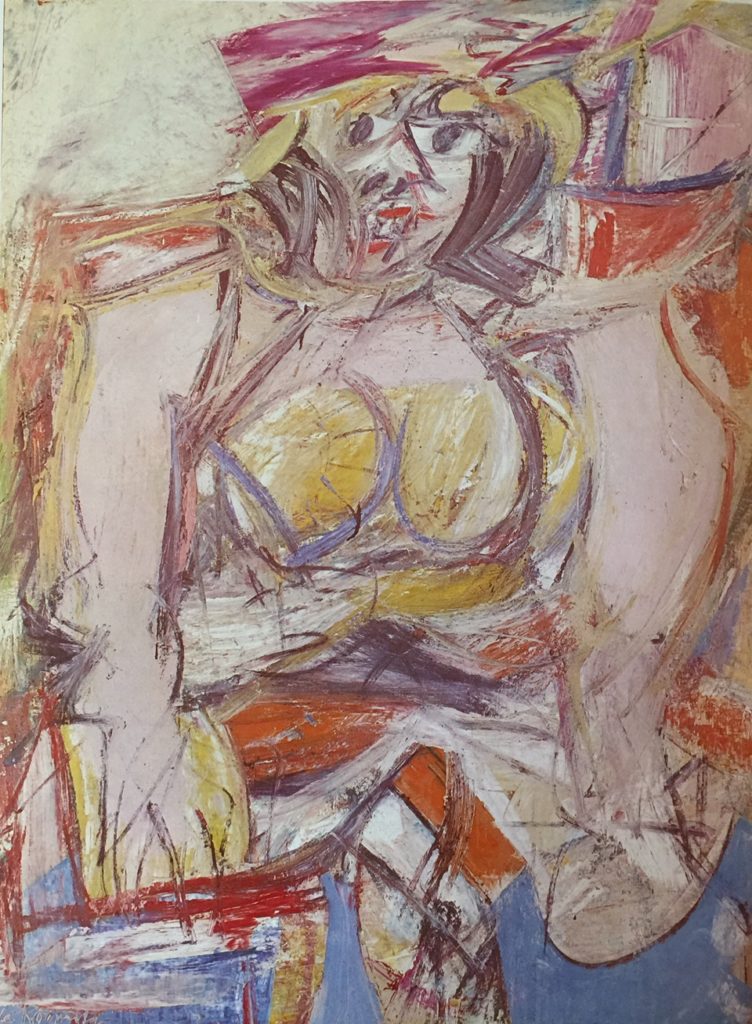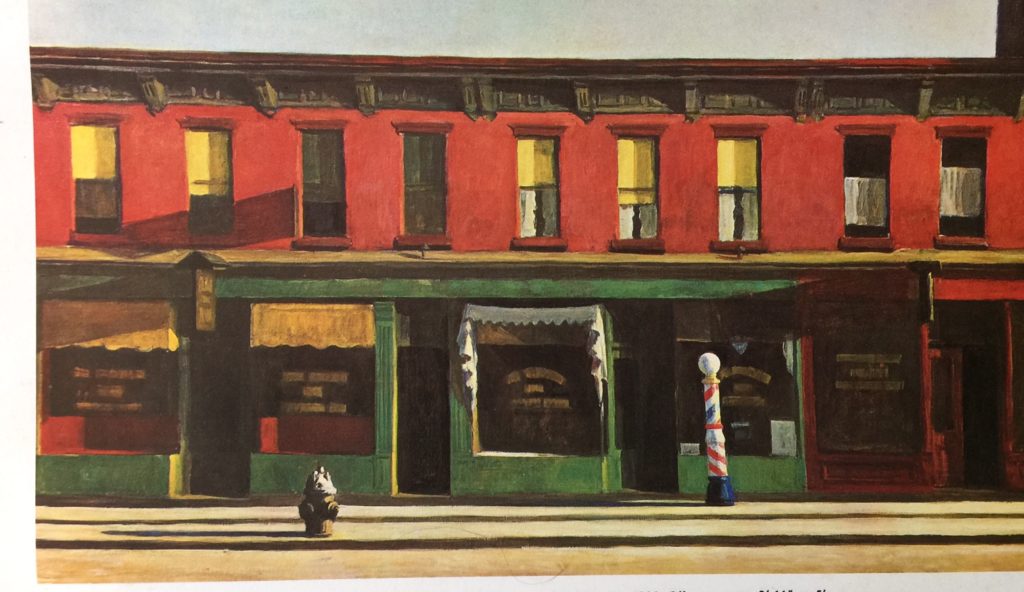Like most young artists, I had my visual heroes when I began my professional career in 1958. As a student at Auburn University, I cut my teeth on abstract expressionists like Willem de Kooning and Franz Kline. I reveled in the imaginative world of Rene Magritte, and I admired and inwardly coveted Andrew Wyeth’s ability to transform the most innocuous landscapes into poetic compositions. But most of all, my first steps as an artist were influenced by the sober work of Edward Hopper.

Willem de Kooning (1952-53)
Nelson Gallery-Atkins Museum
Kansas City, Missouri

Noyes Capehart (1957)
Private Collection

Edward Hopper (1930)
Whitney Museum of American Art
New York
In August of 1958, following my graduation from Auburn, I traveled to New York City with one of my teachers. His intention was to “patch up things” with a girlfriend in Brooklyn before returning to the university for the fall term. At his suggestion, I checked into the YMCA upon our arrival in the city. My mission during that three to five-day time frame was to visit as many museums as I could before making the return trip south with him. He was to contact me in a couple of days with his return schedule.
A long story made short: My teacher never called. Tragically, he drowned two days after dropping me off at the YMCA. As my meager funds were about gone, I faced two options: (1) call my father for bus money home, or (2) find a job and stay in New York City. I opted for the latter, and found work as a guard at the Metropolitan Museum of Art.
At the time of my employment, the Met’s special exhibition galleries were featuring works by ten American artists, among them Georgia O’Keefe, Charles Burchfield, Stuart Davis, and to my great delight, Edward Hopper. As this exhibition was located in the part of the museum to which I had been assigned, I was able to visit the exhibition on a daily basis and study Hopper’s pictures. On those days when I was assigned elevator duty – an assignment loathed by most veteran guards but one which I loved – I was treated to “peeks” of Hopper’s paintings each time the elevator doors opened at the second floor. As the all too familiar saying goes, “I felt like I’d died and gone to heaven,” on elevator days.
One afternoon while doing elevator duty, I was called to the basement. When the door opened, three persons entered the chamber: a balding man I recognized as an assistant curator, a tall, stern-looking man, and a petite woman. As the trio entered my elevator, the tall man was railing away about the Hopper selections in the exhibit, angrily telling the curator that he should have chosen stronger works. The first thought that entered my mind as the tall man registered his displeasure was a critical one: Just who do you think you are to speak so ill of Edward Hopper’s paintings? As the elevator continued its slow journey to the second floor and the exhibition of selected American artists, my irritation at the tall man’s scalding assault and the curator’s lame responses intensified. The woman accompanying the two men had not said a word since entering the elevator.
Wearing my olive-green uniform and facing the instrument panel, I decided that someone needed to counter the tall man’s wrath. His bully-like posture needed to be checked. As I was the only person in the elevator who could step in and silence the unpleasant critic, I did something that was most certainly counter to the duties and responsibilities of a museum guard. I began turning around in order to face the tall man, and as I did so I compressed all of the fingers of my right hand with the exception of the index finger which resembled the barrel of a handgun. Just as I was about half-way though my impromptu pirouette, just when I was about to tell the tall man just what I thought of his unmerited criticism of Hopper’s paintings, just as my balled right hand with the extended index finger was about to point at the tall man’s chest, the small woman said, “Ed, they did the best they could.”
At that precise moment, unable to gracefully cancel my abrupt gesture and retreat to my instrument panel, the thought seared my mind: Ed? Could this man be big Ed? Could this be Edward Hopper? Before I could stop my body in its less than graceful turn, I was facing the abusive man, my extended index finger now hanging limply at my side. A deathly silence enveloped the moment. I looked up and into the tall man’s eyes, and saw a blend of anger and consternation. Before I could more fully process the scrambled feelings and emotions coursing through my mind, I completed my turn and was once again facing the instrument panel.
When the doors opened at the second floor, all three of my passengers exited in silence, each looking at me with puzzled expressions, as if each believed I had momentarily lost my mind. As I watched them walk away from the elevator towards the special exhibition, I realized I could not let my one and only contact with Edward Hopper end on such a sour note. He was, after all, my very favorite artist! I pushed the “Hold” button on the instrument panel, and ran out, hoping to catch up with Hopper before he entered the exhibition. When I did so, I instinctively grabbed one of the sleeves of his shirt and gave it a tug.
Hopper turned immediately and looked down on me with a fierce scowl on his face. Before he could say anything, and as the curator and the petite woman looked on in disbelief, I blurted out, “Mr. Hopper, please forgive me. I just…I mean I only wanted you to know how much I admire your work. I just wanted you to know.”
The awkward moment passed quickly, and I returned to my elevator with a heavy heart. I had made a complete fool of myself, and for a fleeting moment worried that the curator might report my unorthodox behavior. As I was nearing the open door of the elevator, the small woman caught up with me and said, “Please, young man, Ed was touched by your words. It’s just that he doesn’t always know how to respond to such kindness. Thank you for sharing with him your respect for his pictures.”
The blinking light on the instrument panel told me someone on the mezzanine needed a ride. I thanked the small women – Jo Hopper, as I would later learn – and watched the door of the elevator make its silent closure.

Noyes, I did not want you to stop! Your journey has certainly been a fasinating one and I can’t wait to read more.
Thank you, Diane! There will be more.
Come see us!
What a wonderful story Noyes. I did not know the part of about meeting Hopper. Incredible.
Thank you, Beth, for your kind remarks. Yes, “Hopper Day” was indeed a special one for me. Hope all is well with you. -Noyes
What a lovely story, and so well told. I was in suspense during the elevator near-exchange. What a wondrous moment for you, first to know this really was Edward Hopper and then to receive the kind words of his wife.
Personally, I love looking at my “Red Vine” and seeing Van Gogh staring back at me. I look forward to your book!
Noyes, I have told this story to many of my University students over the years.
Thanks the continued inspiration to so many.
Keep painting and keep writing.
Preston Lawing